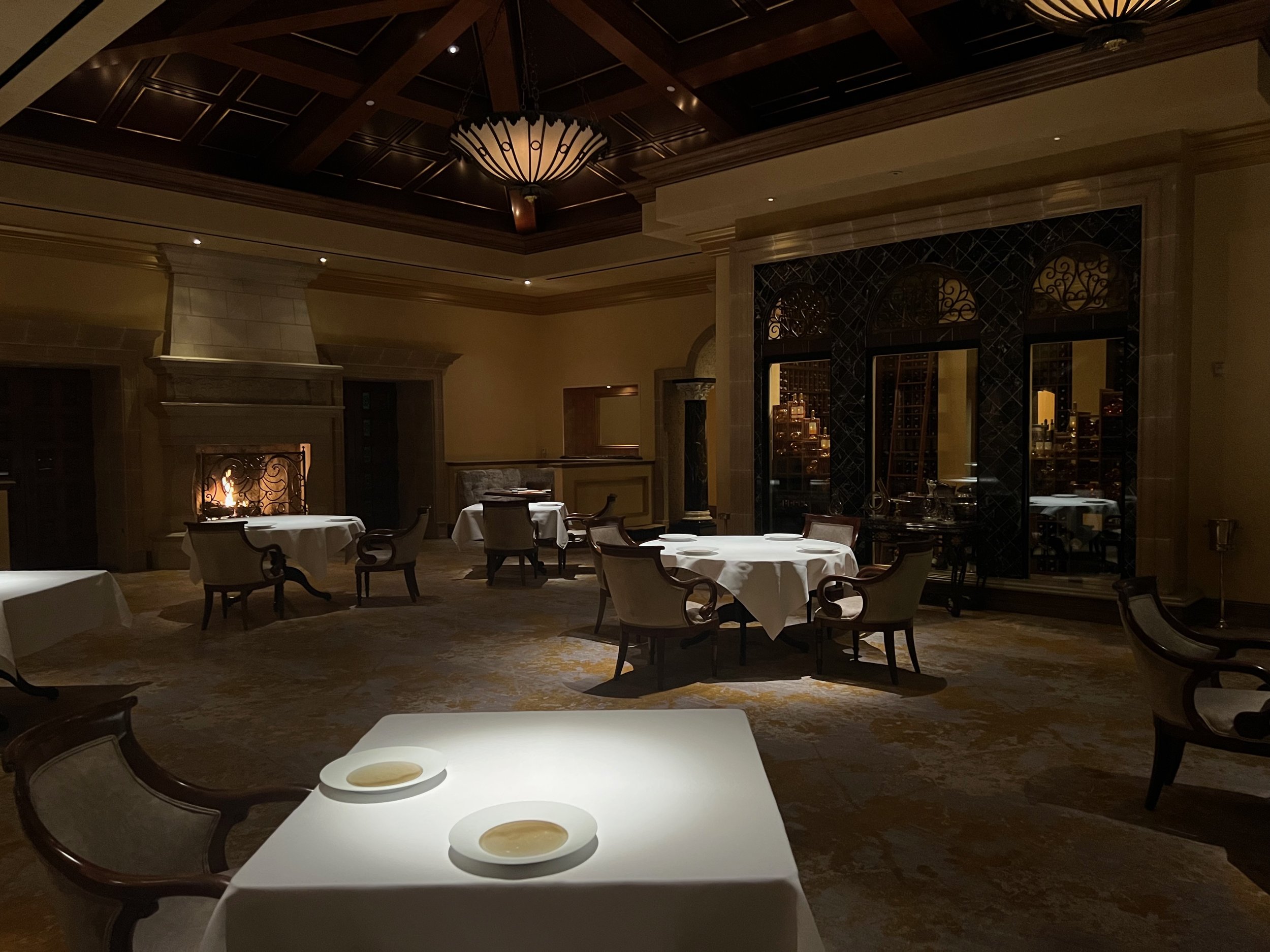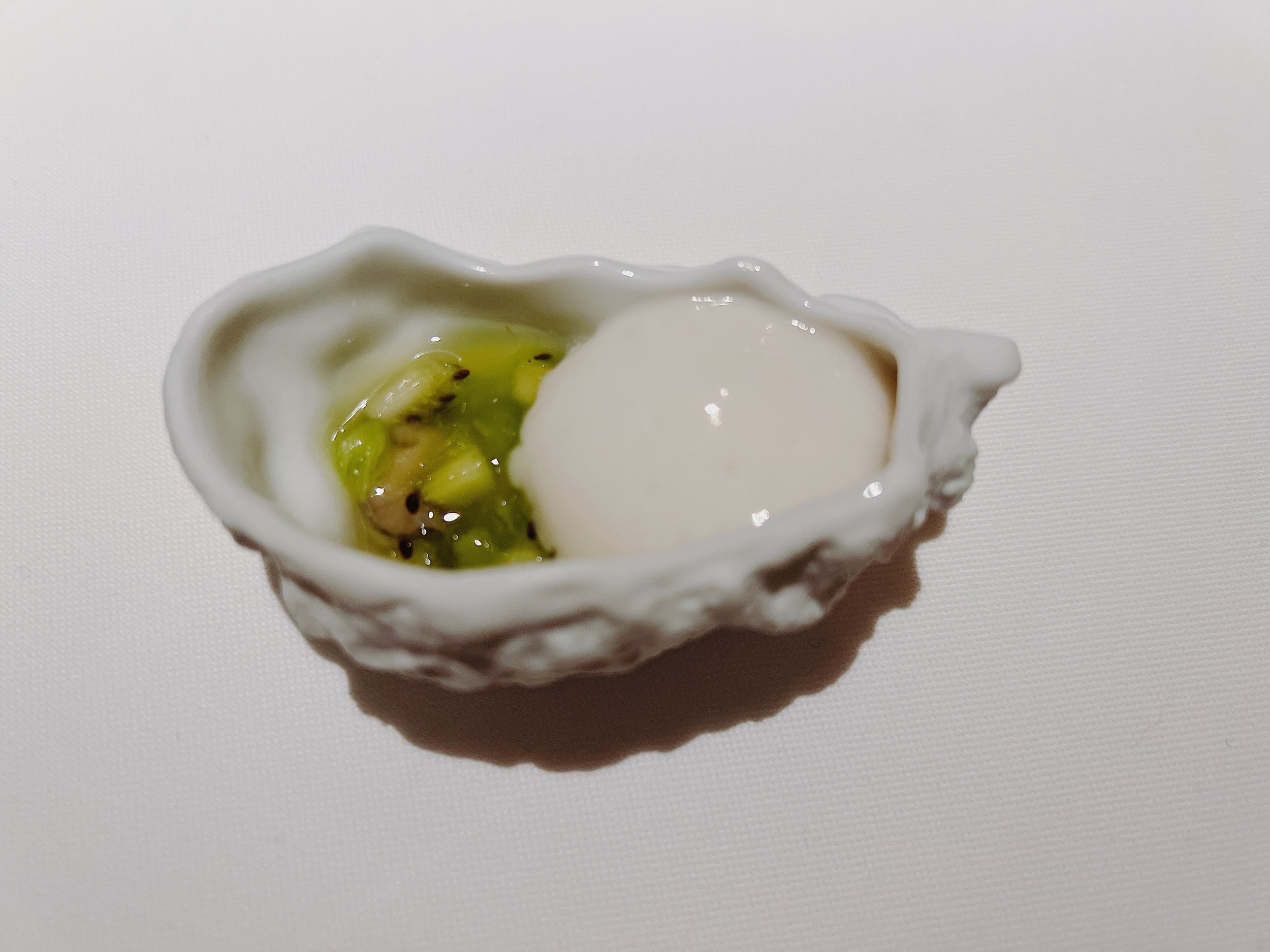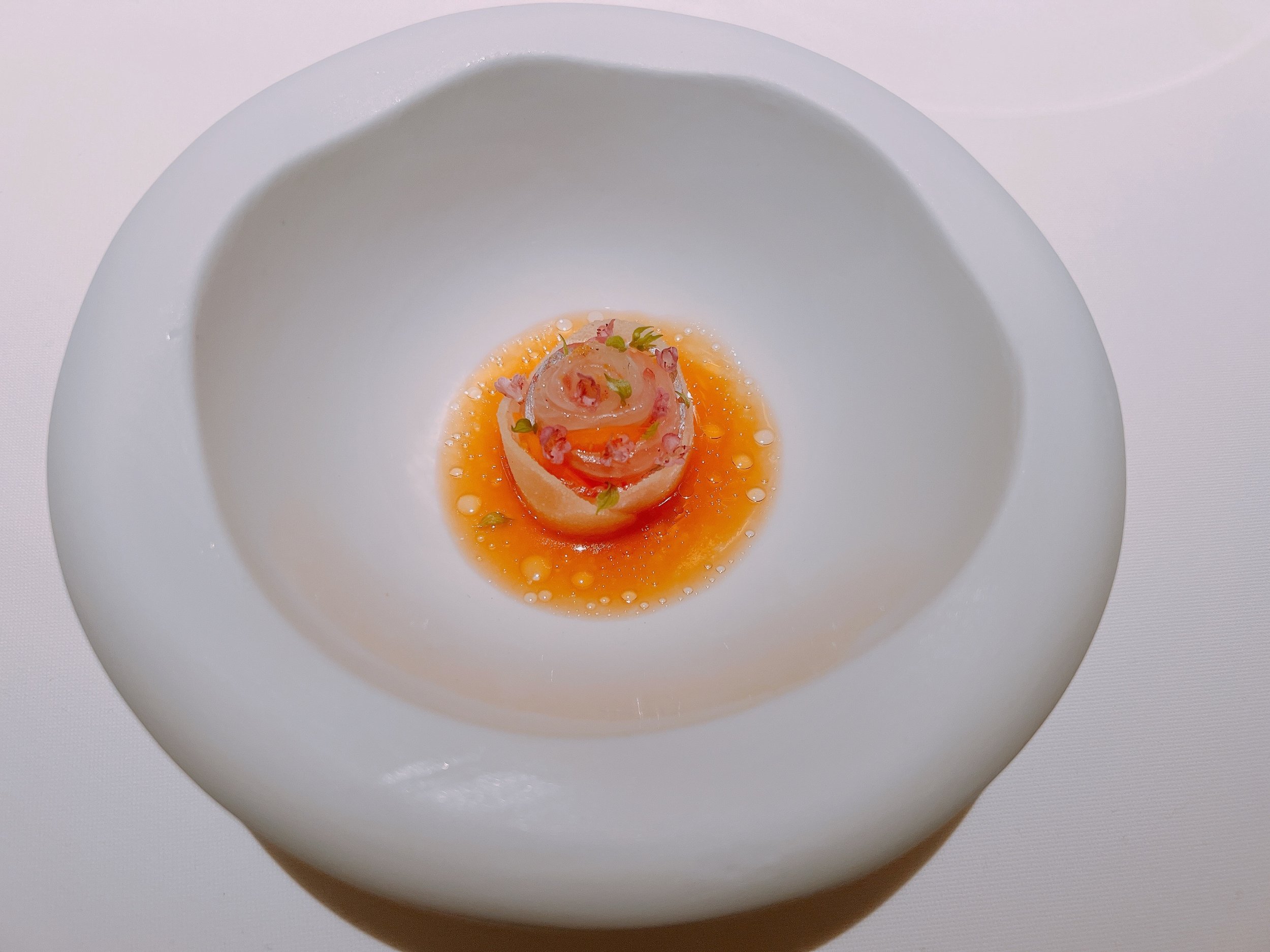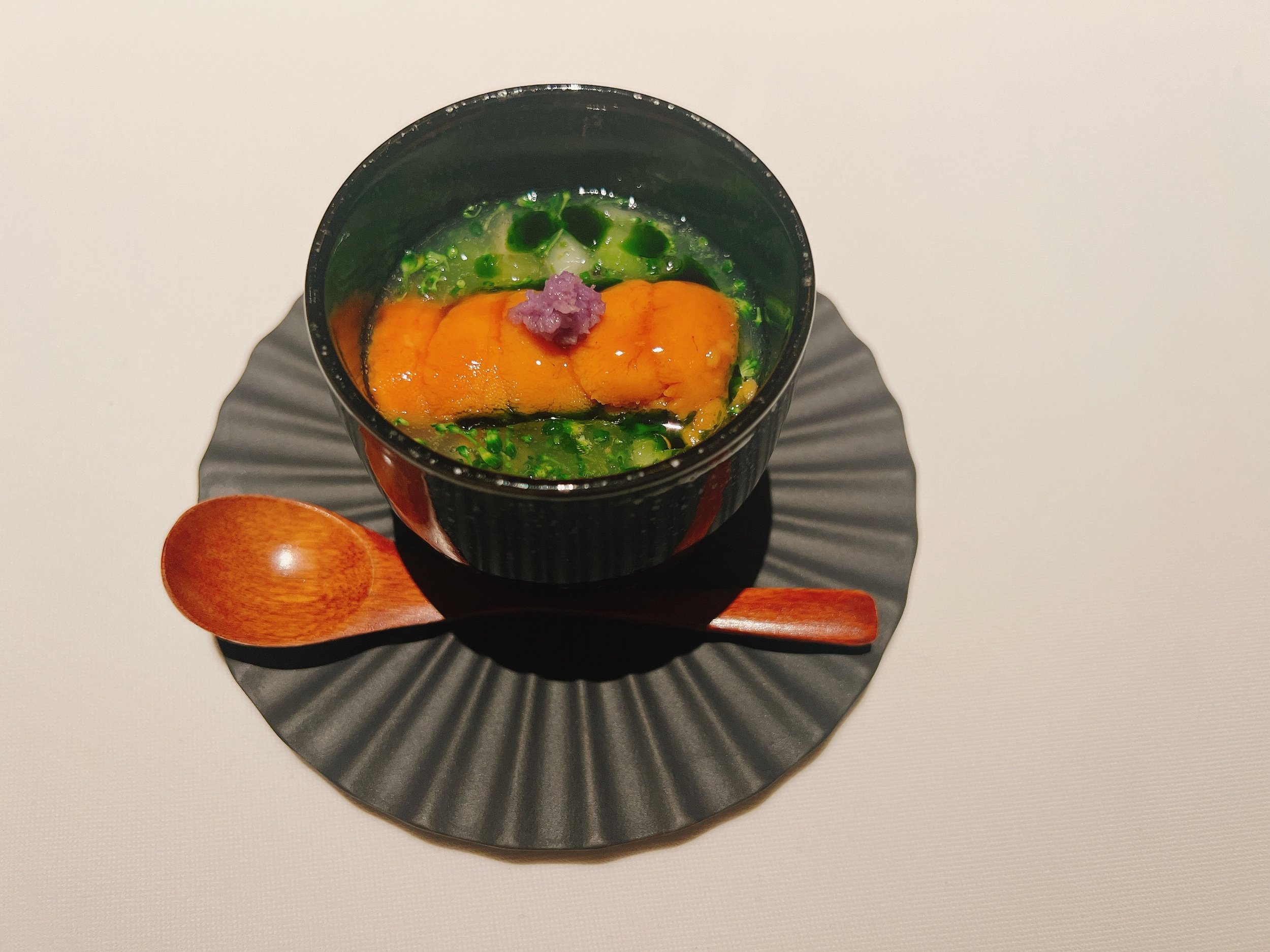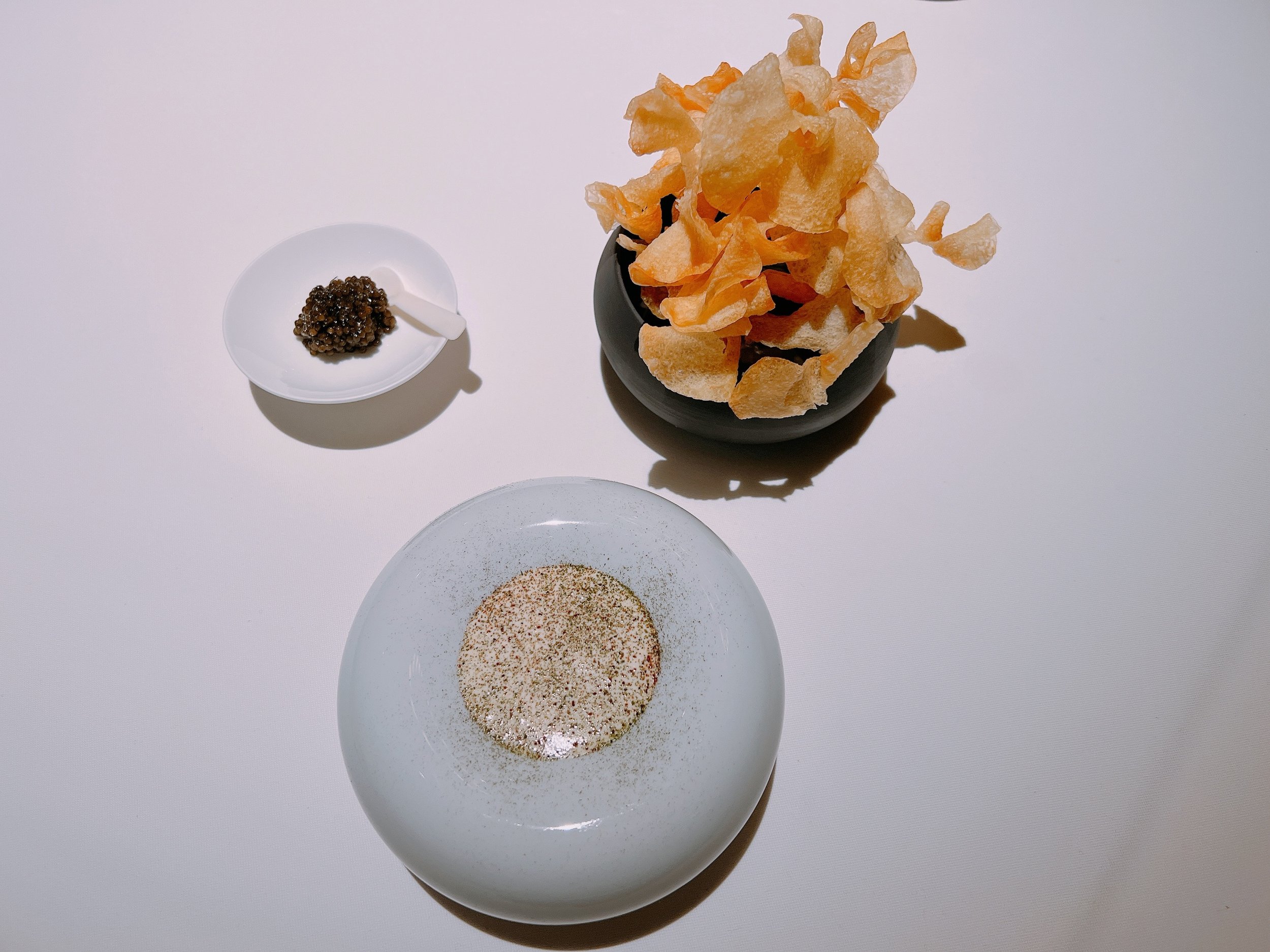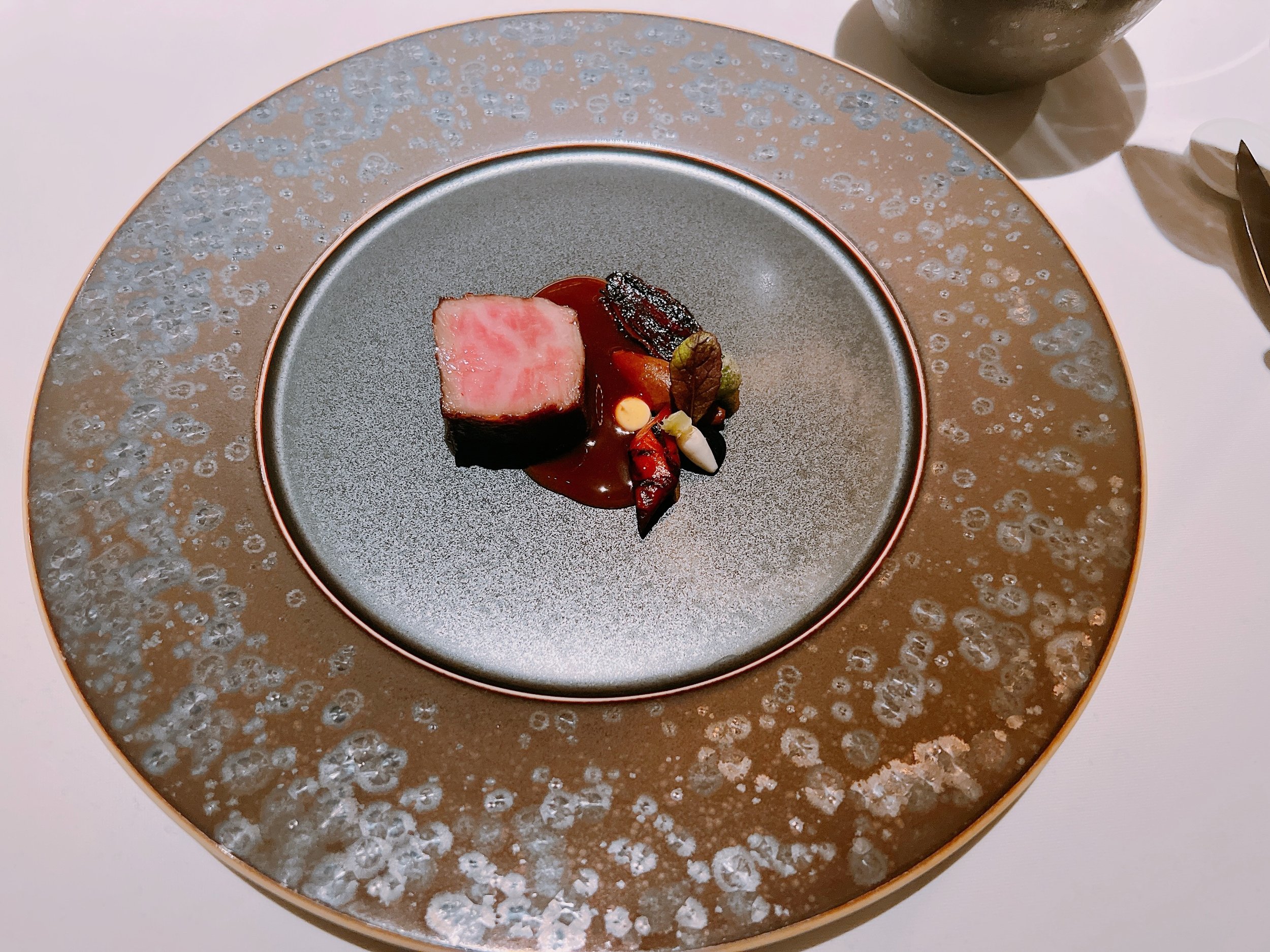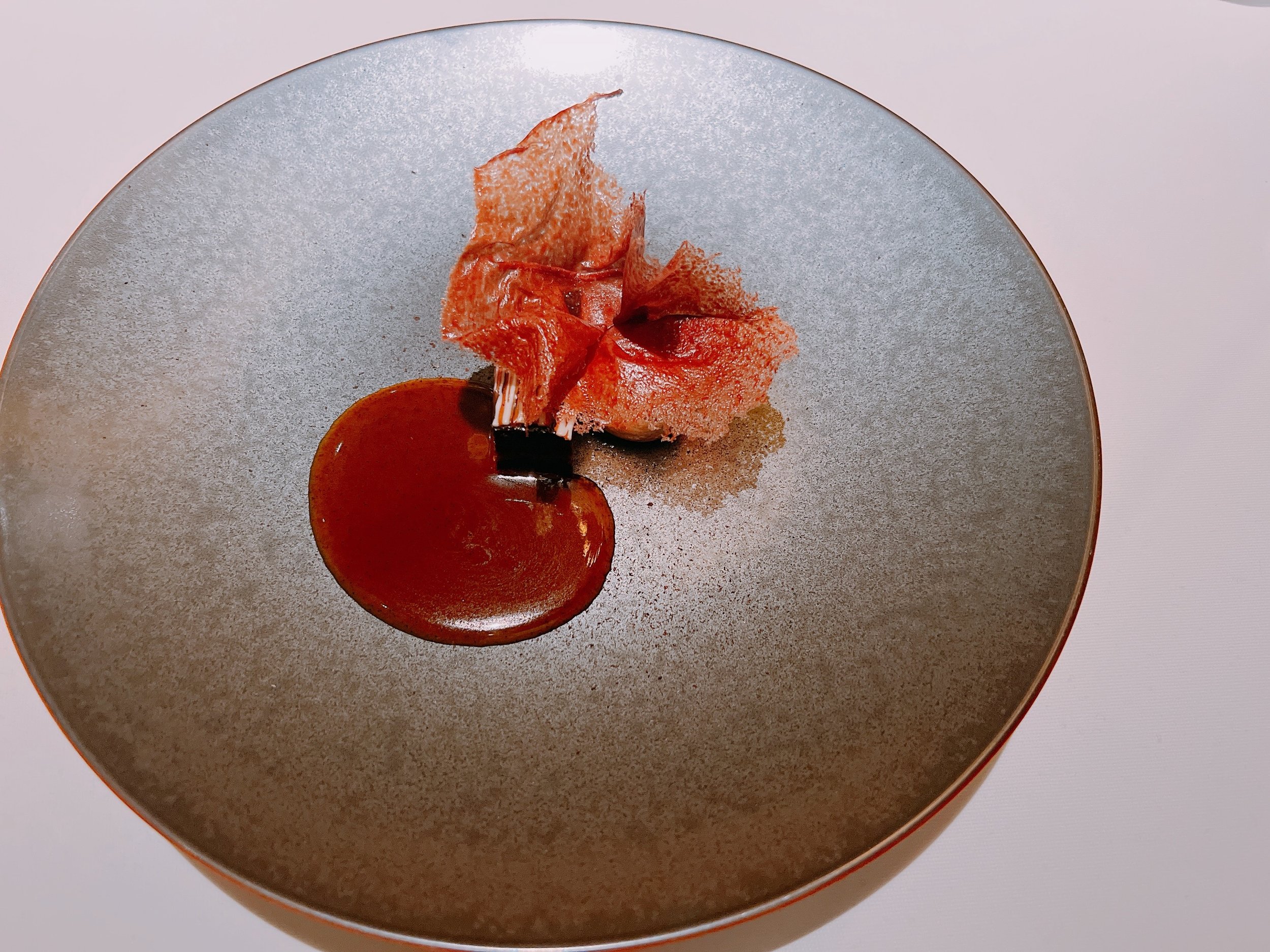Addison - San Diego
Rating: 19/20
Where: San Diego, California
When: Dinner for 4 on 4 March 2023
Cost per Person: Tasting menu $355, Wine pairing $355-$1250+
Accolades: 3 Michelin Stars
Why: Californian cooking that borrows from multiple cuisines; several exceptional dishes
Addison is Southern California's first restaurant to receive three Michelin stars. And, surprisingly, it is not located in the food hot spot of Los Angeles, but instead further south: in San Diego. The restaurant can be found on the expansive (and expensive) grounds of the Fairmont hotel that are a short drive north of the city center. In fact, the hotel's property is so vast that Addison gets its own building all to itself, far from any guest rooms. The restaurant’s building is huge as well, and, apart from the dining room, felt a bit deserted at night. For example, a huge and well-stocked bar was only dimly lit and entirely devoid of customers and staff. The dining room itself is a huge space with tall ceilings, and the tables were spaced at a generous distance from each other. The large windows overlooking the grounds were unfortunately dark during our night-time visit. With white tablecloths and chandeliers, the ambiance is a bit on the dated, formal side, but there was no dress code.
Before getting into the food and wine, though, I need to provide some context. Our previous visit to Addison in 2021 had been quite memorable, but not for a good reason. What had happened?
October 2021
Heading to Addison soon after winning its second star, we got some of what we expected. The food was very good indeed, entirely deserving of Michelin’s rating. Only the fact that the dishes jumped, seemingly at random, between several different Asian cuisines was a bit confusing. So far, so good. But what I found very grating was the restaurant's approach to pricing. And when I say “pricing”, it's pretty much the absence of any prices being mentioned or shown, which led me to the feeling that “if you have to ask, it's probably not for you”. It started with the price of the tasting menu: we were only told that the website was out of date (it listed two tasting menus, but there was only one now). Shouldn't matter, since we don't have a choice anyway, right? Well, the price of the wine pairing was later reported as being the same as the tasting menu (which we didn't know). A second pairing was $200 more, and for a third pairing the sky was the limit - “some people spend $30,000 on this” - clearly we are not those people who “maybe wanted the airline miles” as the staff surmised (and I wasn’t entirely sure whether they were joking or not). The aperitif champagne cart also came without prices displayed or mentioned, but an absurd cost of $250 per glass (!) can easily lead to a rude awakening when the check comes. With the staff hovering whenever a decision needed to be made, say, for the champagne cart, this made for an uncomfortably pressured atmosphere, and a shockingly high bill at the end of our dinner. No matter the culinary qualities of the experience, I was pretty sure that we wouldn't return.
But then on December 5, 2022, Addison received its third Michelin star. Thus, to be able to fairly review the restaurant at its new three-star level, I figured that another trip to San Diego was necessary after all. To be honest, we approached this dinner with some trepidation, and vowed to ask for prices on everything. But we planned to keep an open mind.
March 2023
Just as on our last visit, Addison served only a single tasting menu. However, caviar, wagyu and truffles were available as an upgrade. I had to ask explicitly that yes, all of these could be ordered individually, and yes, they did indeed have prices (caviar: $75, wagyu: $125, truffles: $225). Half of our table tried the caviar and wagyu upgrades, but we passed on the truffles.
There were again three wine pairing selections, at $355, at $555 and at [insert your price here], as long as that price was at least $1250 per person. During our 2021 visit, we tried the two “cheaper” pairing, and found them roughly comparable in enjoyability, so this time we went directly for the “economy pairing” at $355. The wines (and one beer) were all good to very good, and went decently with the food. What surprised me a bit is that almost all of the wines in the pairing were also available by the glass, and the total cost by the glass was roughly the same price as the pairing. But since the pairing pours were much smaller, the per-ounce cost of the pairing was almost twice as high as the price by the glass. It would be more economical to just order the wines by the glass and then split them among two people. Or order a few bottles from the wine list instead, which included many reasonably priced options - a positive surprise for a restaurant in this price range.
While making our food and drinks-related decisions, we enjoyed a “ponche”, a Mexican punch made from guava, hibiscus, winter apple, tamarind, cloves, and other wintry spices. Served warm, it was a nice welcome during one of the coldest winters that San Diego has seen in recent years. The drink was pleasant, and not too heavy on spice 17.
Next came a collection of amuse bouches served at the same time. Our favorite was a Japanese-inspired sake-cured kanpachi (yellowtail) that was served on a meringue with a shiso leaf and some wasabi. A beautiful fish, with a nice kick from the wasabi and a meringue that melted in your mouth - there was a lot of stuff going on here, all coming together in a delicious bite 20. A Kumamoto oyster was served in a ceramic oyster shell with pickled kiwi and a champagne foam. The fresh, acidic kiwi dominated the flavor of this dish, whereas the oyster contributed merely texture and no taste. I’d call this a successful kiwi dish, but less of a success as an oyster dish 17. One of the menu upgrades we had chosen gave us an A5 wagyu tartare that was served inside a squid ink crisp “sandwich”. The wonderfully crunchy crisp and the creamy meat went very well together 18. A cube of potato rösti (think: layered fried potatoes) was topped with Iberian ham. This was easily the most rustic of the bites on offer here, the potatoes were crunchy and quite fatty. Not that I'm complaining, this dish was definitely tasty, and the ham also very nice 18. Even better was the vegetarian alternative, which was topped by alternating layers of truffles and Parmesan cheese. Its flavor profile was more earthy compared to the ham version 18. Back to Mexico: we had “churros”, which were cylinders made from feuilles de brick that were filled with chicken liver and seasoned with cinnamon. I was a bit skeptical after hearing the description, but the combination of sweet and savory worked pretty well, and there was only a hint of sweetness in the end 18. The vegetarian alternative had chilies instead of chicken liver, which made for a fruitier, spicier dish - very, very good 19. Finally, garden greens from Sage Hill (one of the restaurant's suppliers) were served on a cracker pillow that was filled with a sauce that tasted like a mix of cheese and pesto. I loved the filling, the lightness of the dish, and the fact that it was still crunchy after sitting on our table for almost ten minutes 19.
The first “official” course of the tasting menu brought us a return of kanpachi, this time arranged as a rose with pickled hosui pears, shiso flowers and a pichuberry (think: gooseberry) dashi. This was a very enjoyable mix of citrusy flavors and great fish, but I felt that it might have tasted even better when eaten as one big bite, rather than layer by layer as suggested by the staff 19.
More Japanese influences were evident in the following dish of chawanmushi (Japanese egg custard), served with broccoli, celtuce and uni (sea urchin) from Hokkaido. A very good dish - it was so full of crunchy vegetables that it almost felt like a salad, but the eggs and uni added a nice velvety texture 18.
The signature dish of the restaurant came next. It was called “eggs and rice”, and that translated to caviar and a smoky sabayon served with toasted sesame over rice. This was deservedly a signature dish - wonderfully smoky, with some nice saltiness, and the textures of the rice and the creamy sabayon were great complements for each other - excellent 20.
Following and living up to such a wonderful dish would have been hard, but the next course didn't even try. We were served potato chips and a dip containing burnt onions and dill. I thought the dip was delicious, and only wished that there had been more of it. But the potato chips were, apart from their funky shapes, merely regular, plain, salted potato chips - somewhat of an oddity in the middle of a three-star tasting menu. For this course, another menu upgrade materialized in the form of a spoonful of caviar. While this made for a different and somewhat better dish, it's probably not worth the $75 surcharge. Given that this was the only course that was paired with beer instead of wine, I suppose it was casual on purpose, but I wished that there had been some elevating twist that put it more in line with the rest of the menu 14.
I've had kinmedai many times before (in fact, just the preceding night at Sushi Tadokoro), but only now did I learn its English name: “splendid alfonsino”. With a name like that, expectations can't help but being high. The fish was served with its scales cooked (popped) using hot oil, a Japanese preparation technique. It was served with radishes, fennel, artichokes, kombu, a buttery sauce and chive oil. The fish was perfectly cooked, the crunchy skin added a nice texture, and some of the vegetables were even better - full of flavor. Add to that a beurre blanc-ish sauce, and you have a winner. My only complaint was that the dish could have been served warmer than lukewarm 19.
Does a loaf of bread count as a “course”? Debatable, but this sourdough loaf made from heirloom grains dating back to the 1700s was lovely. The crust in particular was amazing - apparently it was made in a longish process where the bread was first partially baked, then sprayed with butter before finally being fully baked. The interior of the bread didn't quite live up to its magnificent crust, it was not particularly fragrant for a sourdough bread. On the side were two dips, one made of brown honey, and one (my favorite) consisting of whipped goat milk 17.
After the bread, the kitchen went back to Asia - this time to Thailand - and sent us a tom kha soup containing slices of Alaskan crab leg. On the side were breaded and deep-fried cubes of what we thought was pork (roasted mushrooms for non-meat eaters). The soup was amazing - there are no three-starred restaurants in Thailand, but if there were and they cooked like this, I'd be on the next flight to Bangkok. A perfect mixture of sour, spicy and creamy, this hit the spot and would have rated a 20 by itself. The fried meat was fine and nicely juicy, but considerably less exciting than the soup. It had a tiny bit of spice, and rated maybe a 16. The roasted mushrooms were very plain in comparison, maybe a 13 (although my wife said that 16 or 17 would be more appropriate). As a whole for the dish, 18.
Between the wagyu upgrade and pescatarian restrictions, we had no fewer than three main dishes at our table. The “standard” main dish was a squab served with a peanut miso sauce and Asian vegetables. It came with a soup made from kombu and scarred scallion. We were instructed to alternate bites of the dish and the soup. Unfortunately, I did not try the squab, but the soup was lovely - noticeably fatty, it went well with all the dishes. The wagyu upgrade yielded an A5 wagyu served with miso eggplant, tempura-ed eggplant, broccoli and roasted scallions, as well as a mirin/sake/soy sauce. The marbled meat was quite fatty, but not too much, so that it was enjoyable without overstaying its welcome. The sides were pretty good as well, making for a filling final savory course 18. The pescatarian (or rather vegetarian) alternative consisted of trumpet and maitake mushrooms, served with broccoli and cauliflower tempura as well as a mustard aioli. Good, but a bit too fried tasting 16.
A “creamsicle” palate cleanser contained cara cara oranges and a coconut cream soda. A lovely dish that combined fruitiness and creaminess 18.
The dinner ended with a dessert spread. The biggest plate featured a coconut/hazelnut crunch, served with a mezcal/passion fruit sauce and a toasted marshmallow. The coconut/hazelnut bar was a bit on the heavy side, but it was well balanced by the more acidic passion fruit and the lighter-textured marshmallow 18. Yuzu custard topped with matcha foam was excellent: light and very fruity 20. A chocolate wafer cone filled with chocolate mousse, pistachios and sour cherry was pretty good too, but on the heavier side. The flavor-balancing cherry was hidden at the bottom of the cone 18. A tartlet containing beets, berries and verjus was a bit tart, which made for a welcome change of flavor 18. Finally, a wildflower honeycomb was just that - nice and sweet 17.
Thus concluded our second dinner at Addison, and we were happy that we had come back to the restaurant after it deservedly earned its third star. The service this time was much friendlier, there were no unwelcome surprises on the final bill, and the food had improved as well: many excellent dishes, and no misses throughout (ignoring the somewhat puzzling potato chips).
Our first visit in 2021 had left me a bit confused regarding the philosophy behind the menu - dishes seemed to jump between California, Japan and Thailand with no rhyme or reason. But this time I finally had my “aha” moment: the two Mexican-inspired dishes (being definitely not Asian) made the experience click for me. The theme of the menu is “Californian cuisine”, but not (only) in the “Chez Panisse” sense of being seasonal and ingredient-driven, but more in reflecting and incorporating the different cuisines that have made their home in the state. Mexican, Thai and Japanese food all fit that bill, as does the sour dough bread (famously of San Francisco) and even the maligned potato chips and beer might be considered representatives of more casual Californian pub culture. So there is an overarching theme behind the menu, but Addison doesn't dwell on it - it's definitely ok to simply enjoy the food.
Overall: Excellent, seasonal cuisine that represents California not just by its ingredients, but also by incorporating Japanese, Mexican and Thai influences. A meal that finds a sense of place exactly because it is so all over the place - just like the food in its home state. With a few exceptional dishes, and a consistently high food quality throughout, this restaurant is definitely worth the trip to San Diego 19.
